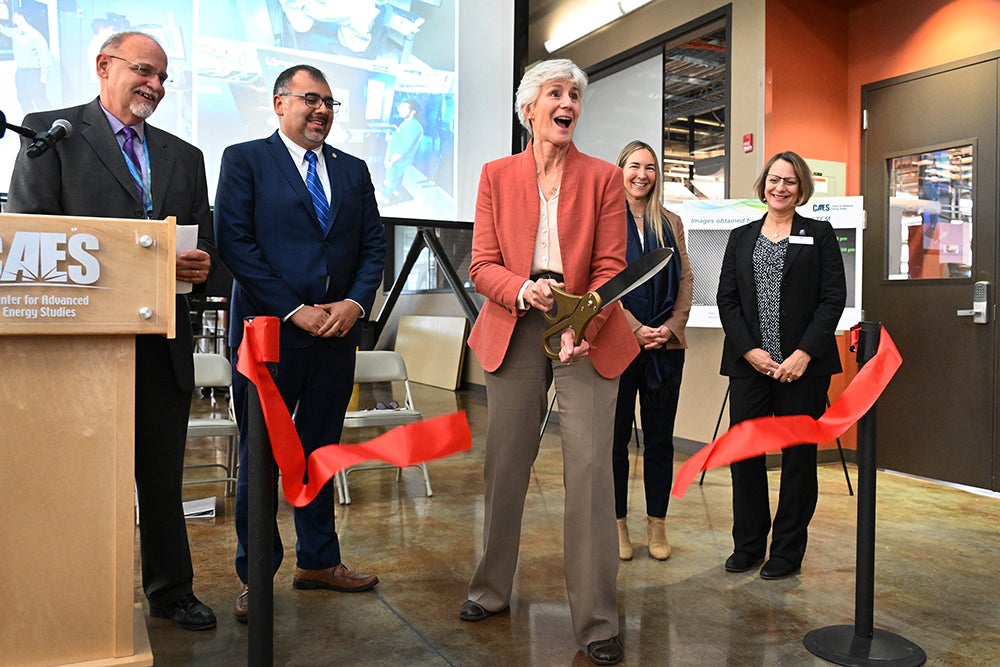
The Center for Advanced Energy Studies (CAES) hosted a ribbon cutting ceremony Nov. 7 in Idaho Falls to unveil a new scanning transmission electron microscope as well as a new 3D metal printer.
The Center for Advanced Energy Studies is a research and education consortium among Idaho National Laboratory (INL), Boise State University, Idaho State University and University of Idaho. The center focuses on nuclear science and engineering, advanced materials science, energy systems design, bioenergy, energy policy, and much more. The new equipment increases the opportunities for collaboration with INL in several mission areas and complements INL’s advanced manufacturing strategy.
The new transmission electron microscope, a ThermoFisher FEI Spectra 300, serves as the centerpiece of CAES’s Microscopy and Characterization Suite and opens access to industry, academic and government researchers from around the world. According to David Estrada, an associate professor with Boise State’s Micron School of Materials Science and Engineering and the associate director of CAES, it is a state-of-the-art tool that will allow researchers to see individual atoms in materials. It is one of the few in the world that has the kind of imaging capability for samples that have been irradiated or emit radiation.
“This tool is a major advancement for materials research in the state of Idaho and the fact that it is at CAES shows how important the collaborations are between INL and the state’s research universities,” Estrada said. “By analyzing how the electrons interact with the material through diffraction, transmission and energy loss, we can gather much information about how atoms are arranged in a sample and their chemical composition.”
In addition to the microscope, a new 3D metal printer will add to the combined capabilities of INL’s Advanced Manufacturing Suite. Marianne Walck, who serves both as deputy laboratory director for science and technology and as chief research officer at INL, said CAES received the new Open Additive PANDA 3D metal printer through a Nuclear Energy University Program grant from the U.S. Department of Energy.
The grant was awarded to a team led by associate professor Mike Hurley of Boise State’s College of Engineering. The award stems from Hurley’s participation in the 2019 CAES Summer Visiting Faculty Program and includes team members from INL and the Boise State Micron School of Materials Science and Engineering. The suite’s combination of assets supports material development, printed substances and structural edited manufacturing at INL and its partner universities, Walck said.
The printer’s unique capabilities allow metal, ceramic and a variety of other powders to be used to manufacture structural components. The tool is complemented by a suite of electronic materials printers and nanoparticle ink synthesis and characterization equipment for on demand manufacturing of electronics and sensors. Estrada said such printers may even be used aboard the International Space Station one day to print electronic materials, enabling scientists there to make circuit board repairs on site for the first time. A demonstration tailored to highlight electronics printing in space is scheduled for 2024.
Boise State University’s Vice President for Research and Economic Development Nancy Glenn said the partnerships among CAES and Idaho’s research universities serve as a catalyst for innovation in the state and region.
“Our universities have a unique opportunity here in Idaho to partner with INL and have access to this equipment,” said Glenn. “I am excited about the science and engineering that will come from the transmission electron microscope and 3D metal printer, the partnership opportunities that we have to grow, both within the state as well as outside the state, and the advanced training on the state-of-the-art equipment that our students will receive.”
– By Michael Freeman